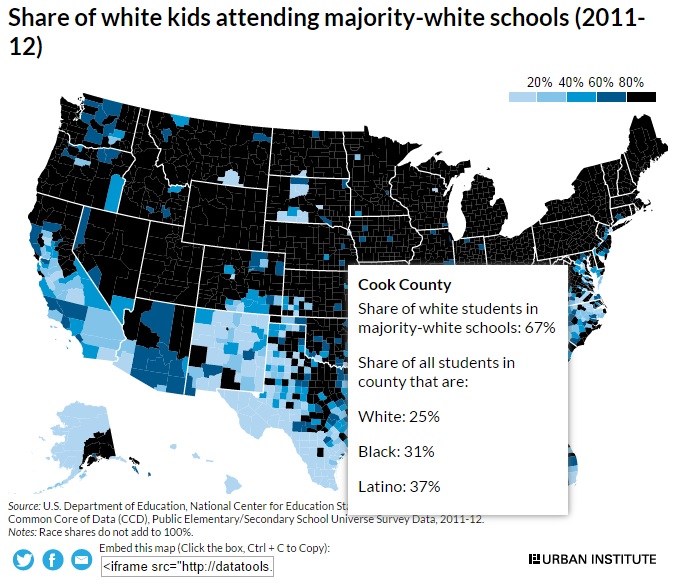
I recently wrote a blog post with county-level maps showing how racially segregated our public schools are. The post received a lot of attention, including comments arguing that county-level data don’t accurately portray the segregation story in large parts of the country.
Specifically, these commenters pointed out that many US counties are (almost) entirely composed of a single race (usually whites) and so to claim school segregation because most students in those counties don’t attend diverse schools is unfair. How could students attend integrated schools if there are no students of different races nearby?

As I pointed out in my earlier post, you can see the pattern of racial segregation and isolation most clearly in large urban counties like Chicago’s Cook County, where white students comprise a minority of all students, and yet most attend majority-white schools.
What’s more, modern school segregation is not the result of legal (de jure) segregation. Instead, it flows from over a century of broader, neighborhood segregation. Note, for example, that most people in the country—including the vast majority of black people—live in metros, so the fact that most metros are highly segregated means that most people live in segregated communities with segregated public schools.
Most important, though, is that it’s not an accident of history that America’s black population is disproportionately located in inner cities while huge swaths of the country have few or no black people at all.
One hundred years of segregation
As is thoroughly documented in works by numerous scholars, and more recently and eloquently described in Ta-Nehisi Coates’s landmark Atlantic article, “The Case for Reparations,” public policy explicitly discriminated against blacks and other people of color in the housing market for a large part of the 20th century. The intention was to keep people of color constrained to inner cities and away from white neighborhoods. The policies were remarkably effective at creating patterns of extreme racial segregation across many metropolitan areas and communities in our country.
The most thorough and systematic publicly supported housing discrimination occurred through a practice called redlining, where the Federal Housing Administration and Veterans Administration from 1935 to 1968 denied financing to black homebuyers and inner-city neighborhoods, favoring suburban development for white families. Various other public and private practices had similar effects of creating residential segregation, including restrictive covenants, real-estate steering, exclusionary zoning practices, and—where these practices failed to keep blacks out of white neighborhoods—the outright intimidation and violence toward blacks seeking homeownership. Although these discriminatory practices were outlawed in the 1968 Fair Housing Act, people of color continue to experience subtle but widespread housing discrimination in the private market, as documented by HUD and the Urban Institute for over 40 years. And the more recent subprime mortgage crisis disproportionately affected black and Hispanic neighborhoods.
Public policy decisions created segregated communities, and persistent discrimination and other complex forces sustain them today, keeping people of color from living in the same neighborhoods as whites. Although the exact mechanisms maintaining segregation may vary by region, the residential segregation of our communities is a significant reason why we have segregated schools. Absent intentional housing or education policy efforts to break the link between segregated communities and segregated schools, we can expect to find segregated schools wherever students are assigned to neighborhood schools.
Why should we care about segregated schools?
A preponderance of evidence demonstrates that students of color and poor students benefit greatly when they attend desegregated schools. Schools with a majority of students of color tend to be located in distressed neighborhoods that lack the resources and supports available in middle- and upper-class neighborhoods. Racial and socioeconomic integration provide high-quality networks and opportunities for low-income students and students of color that are otherwise unavailable in poor, racially isolated schools. Research has shown that racially integrated schools reduce prejudice among students of all races, foster cross-racial understanding, and increase the likelihood of students seeking out homeownership in racially diverse neighborhoods when they’re older.
Beyond deconcentrating disadvantage and reducing inequality for individuals, I find these benefits to society as a whole the most compelling reasons for our increasingly diverse nation to value integrated schools.
Let’s build a future where everyone, everywhere has the opportunity and power to thrive
Urban is more determined than ever to partner with changemakers to unlock opportunities that give people across the country a fair shot at reaching their fullest potential. Invest in Urban to power this type of work.